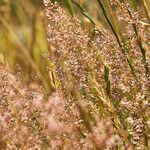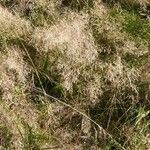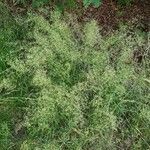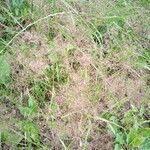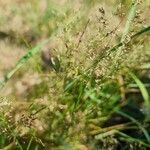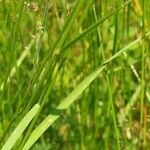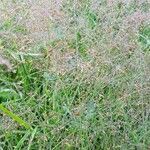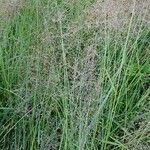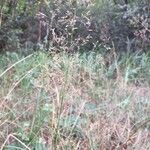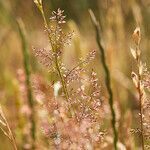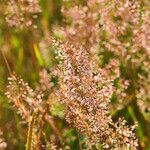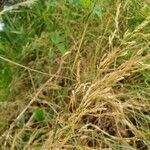Perennial, rhizomatous; rhizomes scaly, short. Culms tufted, geniculate or decumbent and rooting at base, 20–70 cm tall. Leaf sheaths smooth; leaf blades linear, flat or inrolled, 2–15 cm × 1–4 mm, scabrous or nearly smooth, apex acuminate; ligule on non-flowering shoots 1–2 mm, shorter than wide, truncate. Panicle elliptic in outline, up to 20 cm, open, very lax; branches 2–5 per node, spreading, capillary, 1.5–3.5 cm, slightly flexuous, smooth or almost so, bare in lower half, spikelets well spaced. Spikelets 1.5–2.5 mm, purplish brown; glumes elliptic-lanceolate, subequal or lower glume slightly longer, lower glume scabrid along keel distally, upper glume often smooth, apex acute; callus minutely hairy; lemma 2/3–3/4 spikelet length, glabrous, midrib slightly prominent, usually awnless, apex truncate; palea 1/2–3/4 length of lemma. Anthers 0.8–1.5 mm. Fl. Aug.
Erect or geniculate caespitose perennial, rarely shortly rhizomatous or stoloniferous. Culms to 70 cm high, 2–4-noded; mid-culm internodes smooth, glabrous. Leaves scattered; basal sheaths glabrous; ligule 1–2 mm long, obtuse or truncate; blade flat or involute, linear, to 15 (–20) cm long, 1–5 mm wide. Panicles open or contracted, 1–20 cm long, exserted; primary branches alternate in groups of 1–8, spreading, bare toward base. Spikelets 2–3.5 mm long. Glumes subequal, 2–3.5 mm long. Lemma ovate to elliptic, 1.5–1.8 mm long, shortly dentate with nerves exserted as short points or entire, usually muticous or rarely awned, 3–5-nerved, glabrous; awn, when present, about as long as lemma, arising from near base to ±midpoint, not twisted. Palea fully developed, 50–65% length of lemma. Anthers 1–1.5 mm long.
Loosely tufted, rhizomatous and sod-forming, sometimes with stolons as well, 2–6 dm; culms and sheaths smooth; ligule mostly 0.5–2 mm, wider than high, ± truncate; lvs usually spreading or ascending, 2–4 mm wide; panicle 4–15(–20) cm, permanently open, with smooth, divaricate branches and branchlets, even the pedicel-tips smooth; spikelets 2–3 mm, not crowded; glumes glabrous, or scabrous distally on the keel; lemma 1.5–2.5 mm, acute or acutish, rarely awned from the back; callus minutely bearded; palea half to two-thirds as long as the lemma; anthers 0.8–1.5 mm; 2n=28–35. Native of Europe and perhaps e. Can., widely cult. in cooler Amer. for lawns and pastures, and escaped from Nf. to Mich., s. to N.C. and O., and in w. U.S. (A. tenuis)
